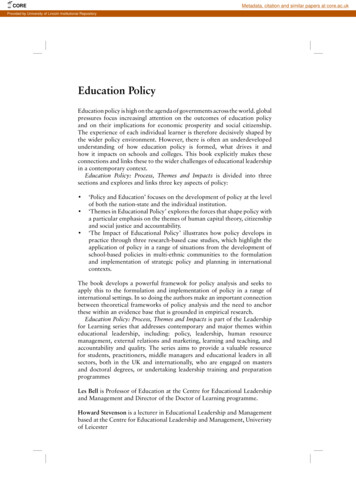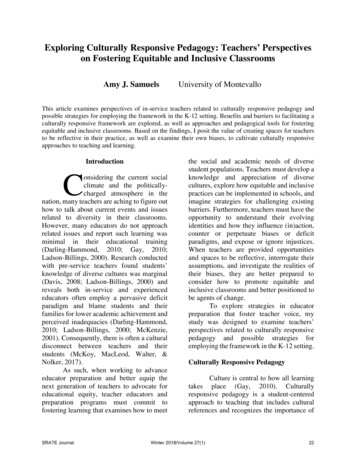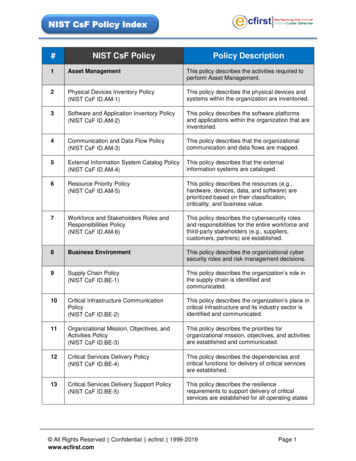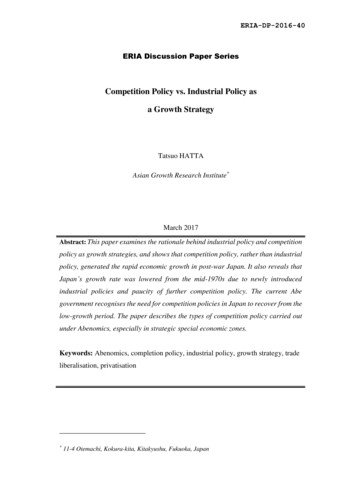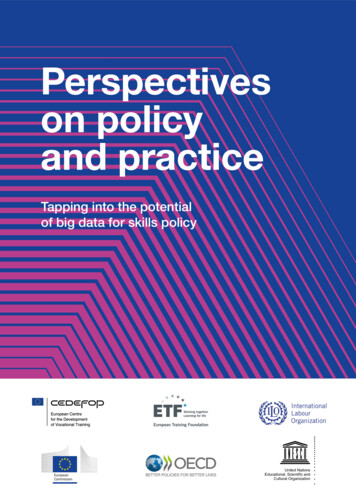
Transcription
Perspectiveson policyand practiceTapping into the potentialof big data for skills policyUnited NationsEducational, Scientific andCultural Organization
PREVIOUSCONTENTSNEXT
PREVIOUSCONTENTSNEXTPerspectives onpolicy and practiceTapping into the potential ofbig data for skills policyLuxembourg: Publications Office of the European Union, 2021
PREVIOUSCONTENTSNEXTPlease cite this publication as:Cedefop; European Commission; ETF; ILO; OECD; UNESCO (2021).Perspectives on policy and practice: tapping into the potential of bigdata for skills policy. Luxembourg: Publications Office.http://data.europa.eu/doi/10.2801/25160A great deal of additional information on the European Unionis available on the Internet.It can be accessed through the Europa server (http://europa.eu).Luxembourg:Publications Office of the European Union, 2021 Cedefop; European Commission; ETF; ILO; OECD; UNESCO, 2021Creative Commons BY 4.0 y/4.0/)PDFISBN NDesigned by Missing Element Prague
PREVIOUSCONTENTSNEXTThe European Centre for the Development of Vocational Training(Cedefop) is the European Union’s reference centre for vocational education andtraining, skills and qualifications. We provide information, research, analyses andevidence on vocational education and training, skills and qualifications for policymaking in the EU Member States.Cedefop was originally established in 1975 by Council Regulation (EEC)No 337/75. This decision was repealed in 2019 by Regulation (EU) 2019/128establishing Cedefop as a Union Agency with a renewed mandate.Europe 123, Thessaloniki (Pylea), GREECEPostal address: Cedefop service post, 57001 Thermi, GREECETel. 30 2310490111, Fax 30 2310490020Email: info@cedefop.europa.euwww.cedefop.europa.euJürgen Siebel, Executive DirectorBarbara Dorn, Chair of the Management Board
PREVIOUSCONTENTSNEXTContentsContents 4Acknowledgements 5Key messages 61. Introduction 2. Labour market and skills trends: the increasing importanceof big data 3. The value added of big data for skills analysis 4. Overcoming challenges and limitations 5. Prospects for data-informed skills policy 79142026Acronyms References Bibliography and further reading 323334
PREVIOUSCONTENTSNEXT AcknowledgementsAcknowledgementsThis perspective on policy and practice was led by theEuropean Centre for the Development of VocationalTraining (Cedefop) on behalf of the inter-agency TVETworking group on Skill mismatch in digitised labourmarkets. Jiri Branka, Vladimir Kvetan, KonstantinosPouliakas and Jasper van Loo (Cedefop) coordinated thework and took the lead in drafting it. The ETF (AnastasiaFetsi, Francesca Rosso and Eduarda Castel Branco), OECD(Luca Marcolin, Marieke Vandeweyer), ILO (BolormaaTumurchudur-Klok, Ana Podjanin, Olga Strietska-Ilina),UNESCO (Hiromichi Katayama, under the guidance ofBorhene Chakroun and Hervé Huot-Marchand) and theEuropean Commission (Michael Horgan) contributedparts of the text and provided examples of global practicein the field of using big data for skills analysis.5
PREVIOUSCONTENTSNEXTKey messages Policy-makers need faster and more detailed information on skills tomonitor and respond to the challenges created by structural economicand societal megatrends and the Covid-19 pandemic. Providing information in (quasi) real-time, online labour market data havegreat potential to improve policy-makers’ understanding of trends in skillsneeds and supply. The strengths of web-based big data include timeliness and granularitycompared to conventional approaches to skills analysis. While web-based big data have significant potential for skills policy, theytend to require more effort to prepare for analysis than data collectedusing conventional approaches. The unstructured information providedoften suffers from statistical, selection and conceptual biases. In low-income countries, web-based big data analysis can provide usefulinsights that complement conventional skills analysis, but biases can bemore challenging. Higher informal employment and a less-developeddigital infrastructure means online recruitment covers only a small partof the job market, particularly urban, formal and white-collar jobs. Thiscomplicates analysis that aims to cover the wider labour market. Despite advancements in information and natural language processing(NLP) and cloud computing, setting up a stable and well-functioningsystem for gathering, processing and analysing big data remainschallenging. Developing such a system is a complicated and resourceintensive endeavour, but one that can pay off in the long-run. Web-based big data cannot and should not replace other skills intelligencemethods and sources. Exploiting the complementarities of big data andother sources of skills intelligence is key in generating statistically robust,detailed, and policy-relevant evidence. It is the combination of artificial and human intelligence that will bekey for further developing big data’s role in shaping effective technicaland vocational education and training (TVET) and skills policies in thecoming years.
PREVIOUSChapter 1.CONTENTSNEXTCHAPTER 1.IntroductionDemographic change, the shift towards more sustainable economies,digitalisation and new forms of ICT-based work are reshaping skill supplyand demand around the world with wide-ranging economic and societalconsequences. These trends, which may have been accentuated bythe Covid-19 pandemic, are profoundly affecting the labour market andincreasing the uncertainty around future skill needs. To shape effective skillspolicies, decision-makers need faster and more detailed collection andanalysis of information on current and future skill needs and trends.Using information available online – or ‘web-based big data’ (Box 1) – forlabour market analysis and skills intelligence is currently high on the policyagenda. While big data analysis is booming in social science research,its widespread use for labour market or education and training policies isstill limited. The main reason lies in the very nature and requirements ofdeveloping and using such data.Box 1. What are web-based big data?Big data are not simply a large data set. The population census of India, which hasmore than 1.3 billion records, is still considered conventional data, because it is collected using standard methods. 3 Vs – high-volume (amount of data), high-velocity(speed of generation and collection, rendering it almost ‘real time’) and/or high-variety (range of different data types and sources) – make data ‘big data’ (Laney, 2001).Experts in the field have proposed (ETF, 2019) two additional Vs: veracity (accuracyand data quality, given that quality cannot be controlled at source) and value (extentto which stakeholder information needs are met).Most big data belong to one of three types: human-generated (individuals submitting own information in social networks,web platforms); process-generated (credit card data, financial transactions); machine-generated (data collected via sensors, mobile phones, internet of things).
PREVIOUS8CONTENTSNEXTPerspectives on policy and practiceIn the context of labour market and skills policies, human-generated informationavailable online is most important. The internet can be used to assess and analyse skills supplied and demanded in job markets. Commonly used sources includeelectronic CVs available through online platforms or social networks, job advertisements published on job portals, and online descriptions of education and trainingprogrammes and qualifications on offer. In this publication, we use the umbrella term‘web-based big data’ to refer to all these sources.Source: I nter-agency technical and vocational education and training (IAG-TVET) working group on Skill mismatchin digitised labour markets. (hereafter IAG-TVET working group).Web-based big data are based on sources that are not primarily designedfor labour market and skills analysis. Firms post job advertisements to attractthe best candidates to their vacant posts. Jobseekers interact with webplatforms and tools to showcase their skills and potential to prospectiveemployers. The information published by education and training institutionsand government agencies responsible for regulating programmes andqualifications also represents a wealth of skills-centred big data.Experts in charge of designing systems for gathering and analysingweb-based big data are not fully in control of the information generationand collection process. The external sources used usually have unevencoverage across occupations, job types, skills levels, sectors and countries.As a result, unprocessed big data raise particular challenges for analysis.Developing a comprehensive and robust system for data collection andanalysis which can mitigate such challenges is a complicated and costlyendeavour. Policy-makers interested in developing such a system shouldfactor in substantial initial investment and be aware of the costs involved inkeeping it operational.This publication has been prepared by the interagency TVET group onSkill mismatch in digitised labour markets, to support experts and policymakers who wish to engage in discussion on the potential of web-based bigdata for skills policy. It outlines how such data can be used to mitigate labourmarket challenges, reduce skills mismatches and strengthen the links betweenthe labour market and education and training. The focus is on overcomingconceptual and practical challenges and limitations, system development andusing big data for skills policy in practice. Examples of big data initiatives fromaround the globe illustrate its potential and provide insight into how big data arealready supporting policy-makers in shaping the futures of work and education.
PREVIOUSChapter 2.CONTENTSNEXTCHAPTER 2.Labour market and skillstrends: the increasingimportance of big dataUsing web-based big data for skills analysis requires a mature online job market.A well-developed internet infrastructure and good and widespread connectivityare preconditions. Without them – as is the case in many low-income countries– the online job market will remain marginal, as many individuals and employerswill not be able effectively to communicate and interact online. Collecting webbased big data in such a context is unlikely to result in information that can beused for solid skills and labour market analysis.While internet access in sub-Saharan Africa and South Asia remainslimited, with internet availability steadily improving and converging across theglobe since 2000 (Figure 1), the potential of collecting and using big data andthe demand for it will continue to grow in coming years. Online recruitmentand job search are becoming more important. In 2018, applications receivedthrough online job portals accounted for a fifth of hires worldwide.Digitalisation, growing internet penetration and increasing digital literacyof the population directly drive the use of the web as a labour market andeducation and training intermediary (Cedefop, 2019a). The economic situation,the structure of labour demand and supply, and the digital preparednessand engagement of education and training institutions, employers and publicemployment services are important indirect factors. The degree of mismatchin the economy also plays a role. Skill shortages incentivise employers to relymore on online job portals; high skill underutilisation and underemploymentmay lead individuals to search more actively for job and education andtraining opportunities online. Legislation or regulation mandating the use ofonline tools is also an important factor contributing to the proliferation of theinternet in labour market and education and training settings (1).(1)In some countries all vacancies must be advertised via a public employment service (PES)website. The unemployed also have to be registered and post their CVs in dedicated web
PREVIOUSNEXTPerspectives on policy and practiceFigure 1. I ndividuals using the internet in different parts of the world(% of population)100908070605040302010East Asia & PacificNorth AmericaEurope & Central AsiaSouth AsiaLatin America & CaribbeanSub‐Saharan dle East & North AfricaWorldSource: International Telecommunication Union (ITU) World telecommunication/ICT indicators database.The expansion of online information on jobs and skills has value goingbeyond the direct benefits users derive from it. Web-based, human-sourcedbig data can play a key role in developing policy-relevant skills intelligence.Apart from helping employers in finding talent, online job advertisements(OJAs) can also be analysed with a view to uncovering sectoral, occupationaland skills trends. On top of their role as tools to promote individuals toprospective employers, online CVs and personal social media profiles canbe analysed to obtain insights into jobseekers’ skills and work experience,career paths and mobility, and engagement in training and learning.Information that characterises education and training programmesand their outcomes, such as programme descriptions, curricula, learningoutcomes/skills and qualifications, can give insight into gaps betweeneducation and training provision and skills needs. Electronic patent andscientific paper repositories can be analysed to understand better theskill needs arising from the diffusion and adoption of technologies. Suchplatforms; schools and training institutions are sometimes obliged to post their studyprogrammes and training offers online. See Cedefop (2019a).
PREVIOUSCONTENTSNEXTChapter 2.Labour market and skills trends: the increasing importance of big datatechnology-focused skills analysis makes it possible to look ahead andidentify leading skills trends which may not yet be visible (2).This publication focuses on using web-based labour market datacontained in online job advertisements and CVs for skills analysis.Advancements in information and natural language processing (NLP) andcloud computing have vitally contributed to the development of big dataanalysis for skills. Web-based big data on skills can be used to generateevidence that complements other types of skills intelligence, such as skillsforecasts, analysis based on surveys or administrative data (3). It can supportpolicy-makers and governments in developing more focused and customisedskills policy interventions. Notwithstanding its potential, providing useful andnovel insights, generating policy-relevant, reliable and high-quality statisticaldata using big data is not straightforward. To gain experience and insightinto how to address key challenges, international organisations have takena leading role in developing approaches and piloting systems using webbased big data (Box 2).Box 2. Unlocking the potential of web-based data for skills analysis:the role of international organisationsCedefop has developed Skills OVATE, a system for gathering and analysing onlinejob advertisements (OJAs) in the European Union. The project will be further developed in cooperation with Eurostat, to pave the way for producing official labourmarket statistics. Cedefop’s OJA project can support other EU initiatives, such asthe European taxonomy for skills, competences and occupations (ESCO). Analysinginformation provided by Europass CV users, the agency has also piloted big dataanalysis of skills supply. Cedefop’s big data work in the coming years will focus onproviding evidence in support of the up- and reskilling ambitions put forward in the2020 EU skills agenda.Building on the achievements of the ESSnet big data project and the long-term cooperation with Cedefop, Eurostat is moving towards tapping the potential of big datato feed into official statistics by implementing the agreements in the Scheveningenmemorandum. To serve EU and other international institutions, it is developing the(2)(3)More information on using patent and bibliometric analysis can be found in: Cedefop (2021,forthcoming). Guide on methods and practices of anticipating new technologies and skills. TheOECD has a long history of analysis of patent and bibliometric data. See, for instance the OECDSTI scoreboard platform and Measuring the digital transformation (OECD, 2019b).See compendium of six Guides on skills anticipation methods produced by ETF-Cedefop-ILO.11
PREVIOUS12CONTENTSNEXTPerspectives on policy and practiceWeb Intelligence Hub, a big data infrastructure which will become a central accesspoint for various types of information.In 2019 the ETF started work on big data for labour market intelligence (LMI) andproduced a methodological big data guide and a feasibility study with guidelines forusers. The aim of this new area of work is to explore the potential of data analytics toimprove the performance of conventional LMI in ETF partner countries (transition anddeveloping countries surrounding the EU). The scope of the analysis is skills demand.The initiative blended exploratory work in mapping the conceptual and methodological underpinnings developed in different countries and research projects. Followingthe feasibility phase based on landscaping sources of online job advertisements in2019 (4), in 2020 the ETF started developing online job advertisement collectionand analysis systems for Tunisia and Ukraine. In parallel, the ETF launched severalstudies on the future of skills in economic sectors and used big data to complementother empirical research methods. Text mining techniques were applied to collatedata on emerging technological trends from patent data and scientific papers, and toidentify emerging skills needs associated with them. The ETFs big data initiative alsocomprises technical dissemination actions and training of statistical and analyticaldepartments and experts, and contributes to the ETF Skills Lab.The ILO has used online job advertisements to assess skills needs. In the context ofits study on a transition to an environmentally sustainable economy, model-basedwork was combined with US OJA data provided by Burning Glass Technologies (BGT).The OJA data was used to proxy employer skills requirements in order to understandtheir reskilling needs (5). The same BGT data set was used in a study analysingthe change in skills demand in the context of global trade. The 2020 ILO reportThe feasibility of using big data in anticipating and matching skills needs bundlescontributions from participants to a 2019 ILO workshop on the topic. A pilot studyto develop a methodology for defining a skills framework for the Uruguayan labourmarket based on job advertisement and job applicant data was in progress at thetime of writing this publication.The OECD is leveraging several sources of big data to support policy analysis andrecommendations. Its 2015 recommendation on good statistical practice advocatesthat national statistical offices explore internet-based sources, and the combinationof these with existing sources for official statistics. In the areas of employment,social affairs and education, data on hiring and online job vacancies are used to an(4)(5)A landscaping study of the online labour market and ranking of OJA sources has also beenconducted for Belarus.The results of this study are presented in the ILO global report: ILO (2019). Skills for a greenerfuture: a global view based on 32 country studies.
PREVIOUSCONTENTSNEXTChapter 2.Labour market and skills trends: the increasing importance of big dataalyse online residual labour and skills demand, describe the career paths of tertiarygraduates, investigate patterns of diffusion of digital or AI technologies and their consequences on the labour market, and improve business cycle forecasting (6). Duringthe Covid pandemic, these data enabled timely analysis of labour market dynamics,including the differential impact of the pandemic on labour market demand acrossUS cities. The next update of the OECD Skills for jobs database will include a modulebased on OJA data to strengthen its measurement of skills imbalances. The OECDAI Policy Observatory gathers and presents information on, among others, labourmarket policies related to the diffusion of artificial intelligence. It also offers datavisualisations of selected web-based labour market big data.UNESCO uses TVET and labour market data to identify and anticipate trends to informMember States about the future of skills supply and demand in the labour marketwithin the framework of its TVET strategy. It also supports the development of data-backed policy and programmes. Due to the cross-cutting nature of TVET and fragmentation of data and statistics, and the lack of data integration between differentMinistries and the private sector, it is difficult to capture accurately the status of skillssupply and demand in the labour market, which is critical for TVET policy development and implementation. While traditional LMI, including administrative and surveydata, already offers a detailed picture of the status of labour markets, big data canhelp improve it. UNESCO’s experience in Malawi and Myanmar demonstrate the potential for combining traditional LMI with big data from online job-search platforms.Source: IAG-TVET working group.(6)See:OECD (2017). Digital economy outlook.OECD (2019a). Benchmarking higher education system performance.OECD (2019b). Measuring the digital transformation: a roadmap for the future.OECD (2020a). OECD Employment outlook 2020: worker security and the COVID-19 Crisis.OECD (2020b). Skills measures to mobilise the workforce during the COVID-19 Crisis – OECDPolicy responses to coronavirus.OECD (2020c). Labour market relevance and outcomes of higher education in four US States:Ohio, Texas, Virginia and Washington.OECD (forthcoming). Measuring the impact of the COVID-19 crisis on jobs and skills demand.OECD Policy responses to coronavirus.OECD (forthcoming). OECD Skills outlook 2021.13
PREVIOUSChapter 3.CONTENTSNEXTCHAPTER 3.The value added of big datafor skills analysisUsing web-based, human-sourced documents to understand skill demandand supply better has several advantages compared to skills informationcollected via conventional methods, such as surveys and administrative data.There are clear limits to using an employer survey to understand skill needsand trends in (detailed) occupations, as only a limited number of skills can beconsidered; simplification is needed to keep the questionnaire manageablefor respondents and it is difficult systematically to capture emerging skillneeds. Unless the sample of the survey is representative (large and costly),analysis typically remains at aggregate level to derive reliable findings.Producing web-based big data requires a data production system (DPS)for data ingestion, data pre-processing, information extraction and data use/presentation (Cedefop, 2019b); see Box 3. While developing such a system iscomplex, the data it provides allow for greater precision in estimates thanksto the large number of observations available and information granularity.This contrasts with well-designed survey data sets, which typically provideunbiased estimates of population parameters but often with lower precision.The main types of information that can be extracted from online jobadvertisements and online CVs (Figure 2) can be used to analyse:(a) skills demand and supply patterns: although employers rarely usea complete skills profile to advertise jobs, the skills (proxies) mentioned inOJAs to assess and select the right applicant for the post provide detailedinsight into skill needs in occupations and sectors. Such informationis difficult if not impossible to obtain via other means (7). CVs, in whichindividuals increasingly emphasise their job-specific and transversal skills(such as language and ICT skills) on top of their formal qualifications andwork experience, can help in characterising elements of skills supply. The(7)For example, the detailed list of ‘skills terms’ in OJAs can be classified using standardtaxonomies, such as the European skills, competences, qualifications and occupationstaxonomy (ESCO v.1) or the O*NET taxonomy.
PREVIOUSCONTENTSNEXTChapter 3.The value added of big data for skills analysis(b)(c)(d)(e)(f)key job tasks and responsibilities people list in their CVs can be used toshed light on job complexity;new and emerging skills: OJAs help identify emerging skill needs linked tonew tasks and technologies, such as those that are not part of standardtaxonomies (e.g. ESCO, O*NET);skills at regional or local level: OJAs typically describe the place of workwell, which facilitates analysis at regional and – provided a sufficientnumber of observations is available – local level. Information on skillsdemand, supply and trends at these levels can be used to strengthenskills ecosystems;diffusion of skill requirements: OJAs can be used to map the proliferationof skills beyond the occupation(s) they are typically associated with;synonyms: OJAs can give insight into new terms employers use to describethe same (set of) skills. This can help enrich existing skills taxonomies;job transitions: as OJAs can be used to map which skills and employmentconditions are similar between different occupations, they can be usedto shed light on potential job transitions within and across occupationsand pay levels. CVs tend to list most or all jobs individuals have held intheir careers. Such information can be used to understand school-towork transitions, experience gains, career progression and occupationaltransitions. Analysis that links career moves and information on skillsdevelopment after formal initial education or training can also informcareer guidance.Figure 2. T ypes of information typically contained in online jobadvertisements and CVs Formal qualificationsFurther trainingWork experienceJobs heldSkills and competencesTasks/responsibilitiesONLINE CVSSource: IAG-TVET working group.ONLINE JOB ADS Detailed occupationRequested skillsOther job requirementsSector of employmentJob contract typeRegion/locality15
PREVIOUS16CONTENTSNEXTPerspectives on policy and practiceBox 3. Collecting and preparing big data for analysis: data productionsystemsDATA merginglanguagesAPIde-duplicatingimport dataDATA USEData LabData ckStoring processed dataData ingestion is gathering primary documents from the web via web scraping (extracting structured data from websites), web crawling (systematically browsing webportals and downloading their pages) or an API (application programming interface) todownload data directly from the database powering a web portal. While using an APIis the preferred ingestion method as the data collected is of higher quality and can bedownloaded much faster, it requires formal agreement with the website owner.
PREVIOUSCONTENTSNEXTChapter 3.The value added of big data for skills analysisStandard andcustom ontologiesPROCESSING AND ANALYSISontology basedmodelspre-processed datastructured andnonstructured fieldsmachine learningmodelsValidation andcorrectionLanguageand DomainexpertsIMPROVING CLASSIFICATIONACCURACYData pre-processing is the process of making information of different quality andcontent suitable for analysis. It involves data cleaning (taking out irrelevant information or ‘noise’), data merging (combining information on the same data point – e.g.a job or a person – from different sources) and data deduplication (removing information that appears in identical form in two or more web sources, such as a jobadvertisement appearing on several online job portals).17
PREVIOUS18CONTENTSNEXTPerspectives on policy and practiceA DPS depends on standard (8) and custom (9) ontologies for processing and analysisof documents. Exact text matching, text similarity or machine-learning algorithms(10) can be used to allocate document content to skill, occupation, industry, regionof the workplace, type of contract, and other categories. To remain relevant andaccurate, ontologies should be continuously updated and enriched using automatedtechniques to reflect labour market and skills trends (11). Domain and language experts validate the machine-powered categorisation and propose corrections. Ontologies can also be updated manually to incorporate such trends, either for particularoccupations or for an entire ontology such as ESCO.Processed data are stored in a multidimensional database, which usually feedsa data presentation platform (DPP) to help users without big data expertise navigatethe data using a graphical interface and a data entry point for more advanced users.A data lab provides experts with an easily and low cost-solution to use the information for basic or advanced data science analysis.Source: IAG-TVET working group and Cedefop (2019b).The ‘bottom up’ information contained in web-based big data is itsmain added value. The more detailed information on skills, occupationsand careers, qualifications and other job requirements and characteristicsin online job advertisements and CVs opens up many opportunities tostrengthen labour market and skills intelligence (LMSI) (Table 1). Trendsanalysis can be undertaken because data can be collected frequently. Suchwork, however, requires sustaining a stable and consistent pool of onlinesources and overcoming continued operational complexities (such as regularmonitoring of web scraping performance and updating of taxonomies).This requires resources to ensure continued tracing over time and can bechallenging given that the online labour market is quite dynamic.(8)Standard ontologies refer to established classifications maintained by external organisations,such as ISCO for occupations, ESCO for skills, ISIC for industry, NUTS for geographical unit,ISCED for educational level.(9) Developed based on infor
Tapping into the potential of big data for skills policy . . PDF ISBN 978-92-896-3235-5 doi:10.2801/25160 TI-09-21-027-EN-N. . qualifications also represents a wealth of skills-centred big data. Experts in charge of designing systems for gathering and analysing
